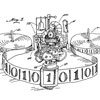Logic Seminar
The purpose of this talk is to provide an overview of the orbit equivalence theory of Borel $\mathbb{R}^n$-flows. An orbit equivalence of two group actions is a bijective map between phase spaces that maps orbits onto orbits. Such maps are often further required to posses regularity properties depending on the category of group actions that is being considered. For example, Borel dynamics deals with Borel orbit equivalences, ergodic theory considers measure-preserving maps, topological dynamics assumes continuity, etc.
Since its origin in 1959 in the work of H. Dye, the concept of orbit equivalence has been studied quite extensively. While traditionally larger emphasis is given to actions of discrete groups, in this talk we concentrate on free actions of $\mathbb{R}^n$-flows taking the viewpoint of Borel dynamics.
For a free $\mathbb{R}^n$-action, an orbit can be identified with an "affine" copy of the Euclidean space, which allows us to transfer any translation invariant structure from $\mathbb{R}^n$ onto each orbit. The two structures of utmost importance will be that of Lebesgue measure and standard Euclidean topology. One may then consider orbit equivalence maps that furthermore preserve these structures on orbits. Resulting orbit equivalences are called Lebesgue orbit equivalence (LOE) and time-change equivalence respectively.
It turns out that properties of LOE maps correspond most closely to those of orbit equivalence maps between their discrete counterparts --- free $\mathbb{Z}^n$ actions. We illustrate this by outlining a proof of the analog for $\mathbb{R}^n$-flows of Dougherty-Jackson-Kechris classification of hyperfinite equivalence relations.
Orbit equivalences of flows often arise as extensions of maps between cross sections --- Borel sets that intersect each orbit in a non-empty countable set. Furthermore, strong geometric restrictions on cross-sections are often necessary. As a concrete example, we explain why one-dimensional $\mathbb{R}$-flows posses cross sections with only two distinct distances between adjacent points, and show how this implies classification of $\mathbb{R}$-flows up to LOE.
We conclude the talk with an overview of time-change equivalence, emphasizing the difference between Borel dynamics and ergodic theory and mentioning several open problems.
